Welcome to KookRecipes.com — where every dish tells a delicious story!
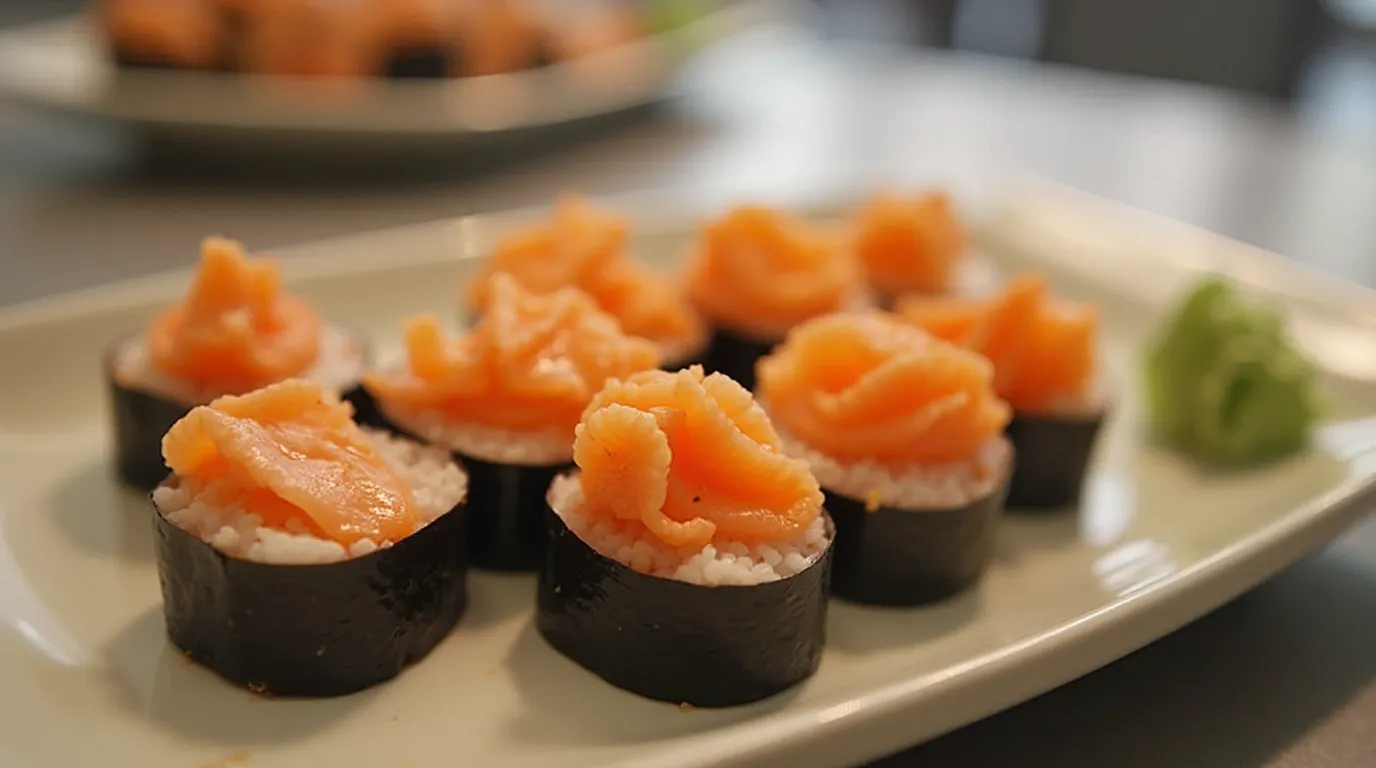
Delicious Salmon Sushi Recipe
To make the best salmon sushi, start with fresh ingredients. You’ll need sushi-grade salmon. It takes about 1 hour and 10 minutes to prepare and 1 hour and 25 minutes to make 6 rolls for 4 people.
With 2 cups of short-grain white rice and 12 ounces of wild salmon, you can make amazing sushi. It’s easy to make at home and you can add avocado or other ingredients to make it your own.
By following simple steps and using the right ingredients, you can make sushi as good as any restaurant. Serve it with pickled ginger and soy sauce for a special touch.
Essential Tools and Equipment for Making Salmon Sushi
To make tasty salmon sushi rolls, you need some key tools and equipment. It’s important to have the right tools to get perfect results when learning how to make salmon sushi.
A bamboo rolling mat is a must for making salmon sushi rolls. It helps you shape and roll the sushi evenly. You’ll also need a sharp knife, like a yanagiba knife, for slicing the salmon and other ingredients. A rice cooker is essential for making sushi rice, and a silicone basting brush is great for applying flavored oils to the sushi fish.
Other useful tools include a kitchen scale for precise measurements and a hangiri (wooden rice bowl) for preparing sushi rice. Here are some of the essential tools and equipment you’ll need:
- Bamboo rolling mat ($4 on Amazon)
- Yanagiba knife ($29 on Amazon)
- Rice cooker
- Silicone basting brush
- Kitchen scale
- Hangiri (wooden rice bowl) (optional)
With these tools and equipment, you’ll be well on your way to making delicious salmon sushi rolls at home. Remember to practice your skills and techniques to achieve even-looking pieces when slicing sushi rolls.
Selecting the Perfect Salmon for Your Sushi
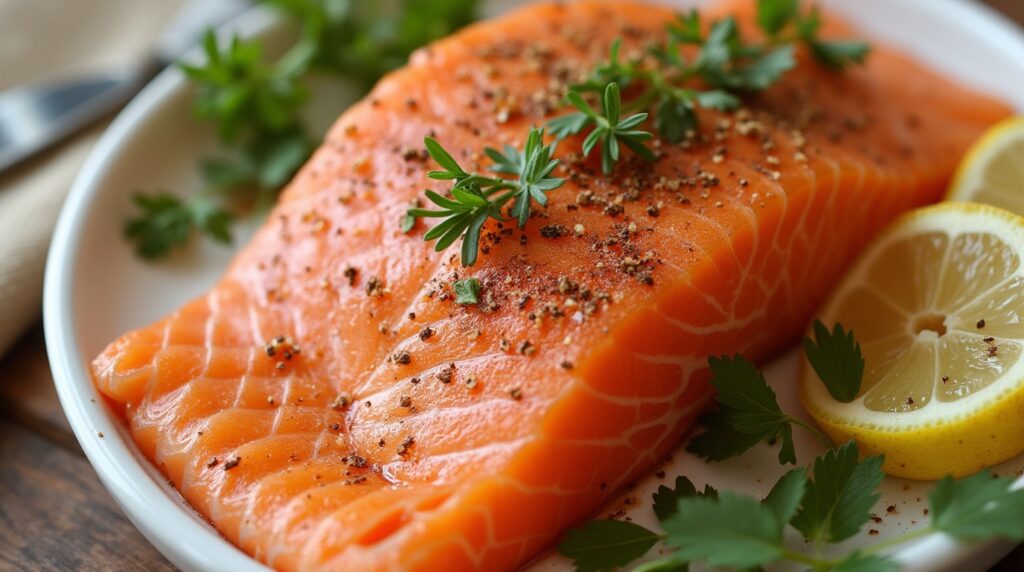
Finding the right salmon for sushi is key. You want it to taste amazing and be good for the planet. Look for fresh salmon sushi near you to find local, high-quality options.
For the freshest salmon, check for clear eyes, firm texture, and a smell like the ocean. Stay away from fish with broken shells or a bad smell. If it’s frozen, make sure it was frozen at 0°F for 7 days or -35°F for 15 hours.
Here are some tips for picking the best salmon:
- Choose salmon from trusted sources that fish sustainably.
- Look at where the salmon comes from. Countries like the USA, Norway, and Japan have strict cleanliness rules.
- Don’t judge the fish by its color. Some farms use processes to make it look better.
By following these tips, you can pick the perfect salmon for your sushi. Enjoy delicious, fresh salmon sushi that’s good for you and the planet.
Preparing the Perfect Sushi Rice
To make authentic salmon sushi, start with the rice. Making perfect sushi rice is an art that needs detail and practice. Use short-grain white rice, which sticks together well when cooked.
Preparing sushi rice involves several steps. First, rinse the rice well and soak it for 10 minutes. Then, cook it with the right water ratio, usually 1:1. Cook for 20 minutes, then steam for 10 minutes.
Here are the key ingredients and steps for preparing sushi rice:
- 1 cup sushi rice or short-grain rice
- 1 1/2 cups water
- 1 1/2 tbsp rice vinegar
- 1 tbsp sugar
- 1 tsp salt
- Rinse and soak the rice
- Cook the rice with the right amount of water
- Season the rice with rice vinegar, sugar, and salt
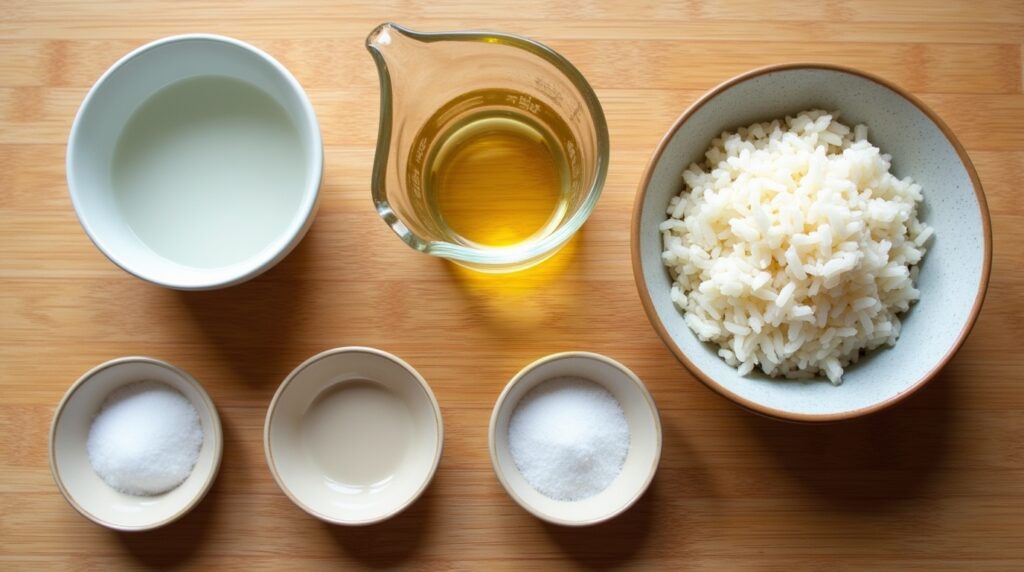
By following these steps and using the right ingredients, you can create the perfect sushi rice for your salmon sushi recipe. This ensures an authentic and delicious experience.
How to Cut Salmon for Sushi
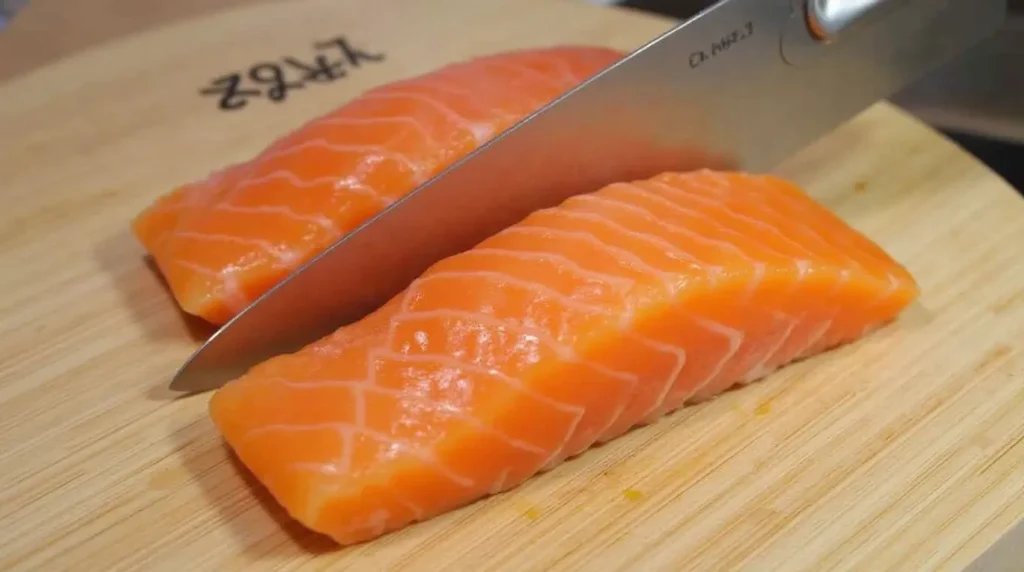
To make tasty salmon sushi rolls, you need to know how to cut salmon. This requires focus and basic knife skills. It’s also key to handle salmon safely to avoid accidents and foodborne illnesses.
Basic Knife Techniques
Begin by setting up a clean and sanitized area. Wash your hands with antibacterial soap. Then, disinfect your knives with a bleach solution.
To cut thin slices for nigiri, hold the knife at a 45-degree angle. Cut in one smooth motion. For sashimi, cut the fillets into strips and then dice them into small cubes.
Creating Even Slices
For salmon sushi rolls, you’ll need long, thin salmon pieces, about 1/2 inch thick. Use a sharp knife and cut smoothly. Remove excess moisture from the salmon with a clean towel before cutting.
Safe Handling Practices
When handling salmon, follow safe practices to avoid cross-contamination. Handle the salmon gently and avoid touching your face or other foods after handling it. By following these tips and using proper knife techniques, you can make beautiful and delicious salmon sushi rolls at home.
Making Traditional Salmon Sushi Rolls
To make traditional salmon sushi rolls, you need a few simple ingredients. These include short-grain white rice, sushi vinegar, salt, sugar, and sashimi-grade salmon. You can find these at most Asian markets or well-stocked supermarkets. A salmon sushi recipe also includes nori seaweed and fillings like cucumber or avocado.
When making authentic salmon sushi, using the right rice is key. Short-grain white rice is best because it’s sticky. Season it with sushi vinegar, salt, and sugar. You can also add sesame seeds or grated daikon to enhance the flavor.
Here are some tips for making traditional salmon sushi rolls:
- Use a bamboo sushi mat to help you roll the sushi evenly and tightly.
- Handle the sushi rice gently to avoid breaking the grains.
- Use fresh, sashimi-grade salmon to ensure the best flavor and texture.
- Experiment with different fillings, such as cucumber or avocado, to find your favorite combinations.
By following these tips and using a simple salmon sushi recipe, you can create delicious and authentic salmon sushi rolls at home. With a little practice, you can master the art of making traditional salmon sushi and enjoy this popular dish in the comfort of your own home.
Creating Nigiri-Style Salmon Sushi
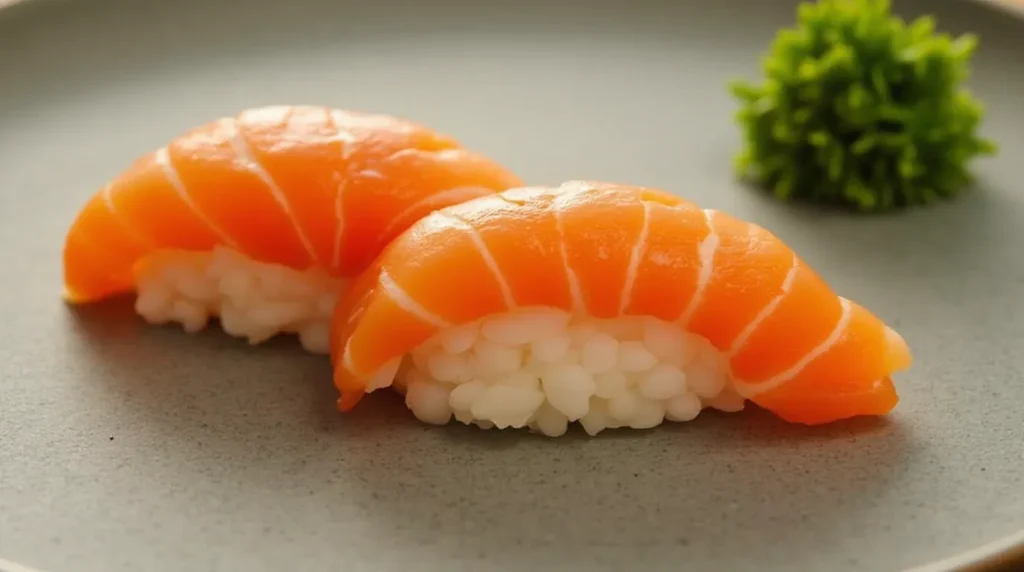
To make nigiri-style salmon sushi, shape the rice into small balls or oval shapes. Wet your hands with water and shape the rice. Making it at home is fun and rewarding.
Place a small piece of salmon on top of each rice ball. Handle the fish gently to avoid damage. For tips on making salmon sushi, check out online resources and tutorials.
Shaping the Rice
Shaping the rice is key in making nigiri-style salmon sushi. Wet your hands with water and shape the rice into a ball or oval. You can also use a mold for the perfect shape.
Proper Fish Placement
Proper fish placement is important. Place the fish on top of the rice ball, making sure it’s centered and balanced. A small amount of wasabi can help hold the fish in place.
Adding Wasabi and Garnishes
Lastly, add wasabi and garnishes to your sushi. A small amount of wasabi adds flavor and heat. Add pickled ginger and soy sauce for extra flavor and presentation.
Popular Salmon Sushi Variations
Creating an authentic salmon sushi recipe is fun and full of possibilities. You can mix different ingredients to find unique flavors. For the best taste, use sashimi-grade salmon. It melts in your mouth.
You can make your salmon sushi recipe your own. Add avocado, cucumber, and cream cheese for a tasty mix. Jalapeño or wasabi mayo adds a spicy touch. For a gluten-free choice, try soy paper instead of seaweed.
Here are some salmon sushi variations to try:
- Spicy salmon rolls with jalapeño and wasabi mayo
- Salmon sashimi with soy sauce and wasabi
- Salmon nigiri with a ball of vinegared sushi rice and a slice of salmon
- Philadelphia roll with salmon, cream cheese, and cucumber
To make great salmon sushi, use fresh ingredients and try new flavors. With practice, you can make sushi as good as your favorite restaurant.
Essential Sauces and Accompaniments
To make your salmon sushi rolls better, you need the right sauces and sides. Learning how to make salmon sushi means knowing these key elements. Sauces like sushi vinegar, wasabi, and soy dipping sauce are must-haves in Japanese cooking. They’re easy to make.
Making sushi vinegar is simple. You mix rice vinegar with sugar and salt. This vinegar seasons the sushi rice, adding flavor and texture. Wasabi gives a strong heat, while soy sauce adds a salty taste to your sushi.
Making Sushi Vinegar
Sushi vinegar is key for tasty salmon sushi rolls. You need rice vinegar, sugar, and salt. Heat the mix until the sugar and salt dissolve, making a flavorful vinegar.
Preparing Wasabi and Soy Dipping Sauce
Wasabi and soy dipping sauce are must-haves for salmon sushi. Mix wasabi paste with water for wasabi. Soy dipping sauce is soy sauce mixed with sake or mirin. These sauces boost your sushi’s flavor and texture.
Traditional Garnishes
Adding pickled ginger and sesame seeds can enhance your salmon sushi. Pickled ginger cleanses your palate, while sesame seeds add a nutty taste and crunch. Using these sauces and sides makes your sushi more authentic and tasty.
Proper Storage and Food Safety Tips
When making and storing fresh salmon sushi, it’s key to follow food safety tips. This helps prevent foodborne illnesses. To keep your sushi fresh and safe, proper handling and storage are essential.
Important tips include refrigerating sushi at 5°C (41°F) or below. Also, store raw seafood at -20°C (-4°F) for 7 days to kill parasites. Always keep raw and ready-to-eat foods separate. Regularly sanitize surfaces and equipment.
Here are some tips for keeping your sushi safe and fresh:
- Store raw seafood in a sealed container at the bottom of the fridge to avoid cross-contamination.
- Keep cooked rice hot at or above 60°C (140°F) to stop bacteria from growing.
- Refrigerate sushi rolls right away, and throw away leftover rice by the end of the day.
By following these tips, you can enjoy your salmon sushi safely. Always handle and store your sushi with care. Food safety should be a top priority in your kitchen.
Conclusion: Mastering Your Homemade Salmon Sushi Journey
Making delicious salmon sushi at home needs hard work, practice, and attention to detail. By using the tips and techniques from this guide, you’re getting closer to being a salmon sushi expert. The secret to great homemade salmon sushi is using the freshest salmon and learning how to make perfect sushi rice.
Salmon sushi is loved all over the world. Salmon and avocado maki is a favorite in sushi places and homes. Adding salmon to your meals can make you healthier because it’s full of omega-3s, protein, and vitamins.
Try out different salmon sushi recipes like Spicy Salmon Maki or Philadelphia Maki. Making your own unique sushi can wow your loved ones.
It’s important to keep your sushi fresh and safe. Eat your homemade sushi right away. If you have leftovers, put them in a sealed container in the fridge and eat them within 24 hours.
Enjoy the process of learning to make authentic Japanese salmon sushi at home. With patience, hard work, and a love for sushi, you’ll soon be making sushi as good as restaurants. Happy rolling!
FAQ
What is the history of salmon in Japanese cuisine?
Salmon sushi has a long history in Japan, starting in the 15th century. Over the years, different types of salmon sushi have developed. Each has its own taste and texture.
What are the different types of salmon sushi?
You can make many kinds of salmon sushi at home. Some favorites include spicy salmon rolls, salmon sashimi, and salmon nigiri.
What essential tools and equipment are needed to make salmon sushi at home?
To make great salmon sushi, you’ll need a few key tools. These include a bamboo rolling mat, a sharp knife, and a rice cooker.
What is the difference between fresh and frozen salmon for sushi?
Choosing the right salmon for sushi is important. You should know the differences between fresh and frozen salmon. Also, learn about sushi-grade standards and where to find quality salmon.
How do I prepare the perfect sushi rice?
Making perfect sushi rice is an art. It needs attention to detail and practice. Use the right rice, cook it right, and season it with the perfect flavors.
What are the proper techniques for cutting salmon for sushi?
Cutting salmon for sushi can be tricky, but it’s doable. Learn basic knife skills, how to cut even slices, and safe handling practices.
How do I make traditional salmon sushi rolls at home?
Making traditional salmon sushi rolls is fun and rewarding. You’ll need a few ingredients and techniques. These include preparing sushi rice, cutting salmon, and assembling the rolls.
What are the steps for creating nigiri-style salmon sushi?
Making nigiri-style salmon sushi is an art that needs practice. It involves shaping rice, placing fish, and adding wasabi and garnishes.
What are some popular salmon sushi variations I can make at home?
There are many salmon sushi variations you can try at home. Some favorites include spicy salmon rolls, salmon sashimi, and salmon nigiri.
What essential sauces and accompaniments should I use with my salmon sushi?
Using the right sauces and accompaniments can enhance your salmon sushi. Try sushi vinegar, wasabi, and soy dipping sauce.
How do I properly store and ensure food safety with my salmon sushi?
Storing and handling salmon sushi safely is important. Follow proper storage and food safety practices to avoid foodborne illness.





